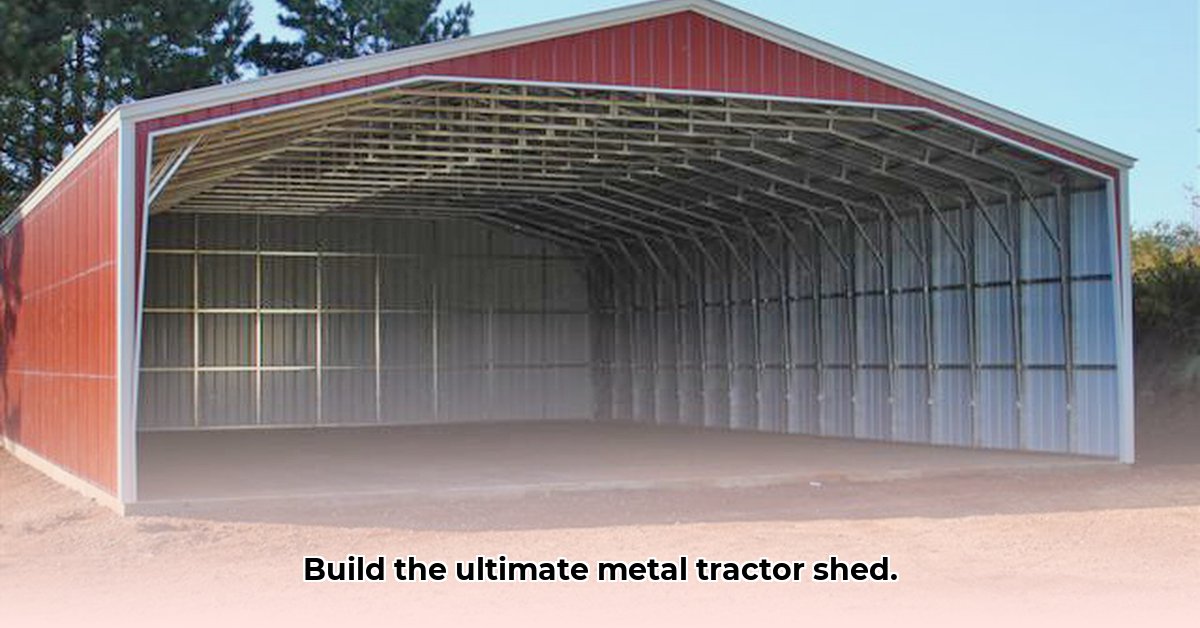
Building a durable and sustainable tractor shed is crucial for protecting your valuable equipment and minimizing your environmental impact. This guide provides a step-by-step approach to designing and constructing an effective metal shed, balancing practicality with sustainability. For more shed design ideas, check out this helpful resource: Tractor Shed Ideas.
Material Selection: Metal vs. Wood – A Sustainable Comparison
Choosing between metal and wood for your tractor shed involves considering several key factors: cost, durability, maintenance, and environmental impact.
Metal (Steel):
Pros:
- Exceptional Durability: Metal sheds offer superior resistance to harsh weather, high winds, and heavy snow loads. They require minimal repairs and have an extended lifespan.
- Low Maintenance: Compared to wood, metal requires significantly less upkeep, saving you time and resources. Occasional rust prevention may be necessary.
- Fire Resistance: Metal is inherently less flammable than wood, providing enhanced safety.
- Recyclability: Metal components can often be recycled at the end of the shed's life, promoting sustainability.
Cons:
- Higher Initial Cost: Metal sheds generally have a higher initial purchase price than wood sheds.
- Rust Potential: Rust can occur if not properly maintained; regular inspections and preventative coatings are necessary.
- Embodied Carbon: Steel production has a relatively high carbon footprint. However, the extended lifespan of a metal shed can offset this over time, especially when using recycled steel.
- Ventilation: Designing for adequate airflow in a metal shed requires careful planning.
Wood:
Pros:
- Lower Embodied Carbon (Potentially): Sustainably sourced wood boasts a significantly lower carbon footprint compared to steel. Look for certifications like FSC (Forest Stewardship Council).
- Natural Ventilation: Wood naturally allows for better air circulation, reducing moisture buildup and the risk of mold or rust compared to metal.
- Aesthetic Appeal: Many farmers prefer the traditional aesthetic of a wood structure.
- Lower Initial Cost (Often): Wood sheds are often cheaper initially than metal sheds.
Cons:
- Higher Maintenance: Wood requires routine maintenance, including painting, sealing, and potential repairs to prevent rot, insect damage, and general wear.
- Susceptibility to Damage: Wood is more vulnerable to rot, insect infestation, and fire compared to metal.
- Shorter Lifespan: A wooden shed generally has a shorter lifespan than a properly maintained metal shed.
Risk Assessment Matrix:
The following table presents a simplified risk assessment. Specific risks vary depending on factors like material quality, local climate, and construction methods.
| Material | Failure Risk | Environmental Impact (Sustainable Sourcing Considered) | Cost Risk |
|---|---|---|---|
| Metal (Steel) | Low | Moderate | Moderate |
| Sustainable Wood | Moderate | Low | Moderate |
| Recycled Steel Metal Sheds | Low | Low | High |
Note: Recycled steel sheds offer the lowest environmental impact but often represent a higher upfront investment.
Design Considerations: Optimizing Your Shed's Functionality and Sustainability
Effective shed design is crucial for both functionality and longevity. Consider these factors:
- Size: Accurately determine the required size to accommodate your largest equipment with ample maneuvering space.
- Ventilation: Ensure sufficient airflow to prevent moisture accumulation. In metal sheds, strategically placed vents and louvers are crucial.
- Drainage: Proper drainage prevents water damage to the foundation and structure. Ensure a slight slope away from the shed and consider gutters.
- Sustainability Features: Explore integrating eco-friendly elements like rainwater harvesting systems or solar panels to minimize environmental impact.
Construction Process: A Practical Overview
While a comprehensive step-by-step guide is beyond this scope, key construction stages include:
- Site Preparation: Thoroughly clear and level the site, ensuring proper drainage.
- Foundation: A sturdy, level foundation (concrete is recommended) is essential for a stable structure, especially considering the weight of a metal shed.
- Assembly: Carefully follow the manufacturer's instructions, taking your time for proper assembly.
- Finishing Touches: Seal seams to prevent leaks. Install ventilation systems and ensure proper drainage.
Regulatory Compliance: Understanding Local Building Codes
Before starting construction, contact your local authorities to obtain necessary permits and confirm compliance with building codes and zoning regulations. Failure to do so can lead to fines or legal issues.
Budgeting and Cost Analysis: Planning for Your Investment
A detailed budget is essential for successful project management, encompassing:
- Material costs (steel, concrete, fasteners, etc.)
- Labor costs (if hiring contractors)
- Permitting fees
- Contingency for unexpected expenses
Maintenance and Longevity: Maximizing Your Investment
Regular maintenance significantly extends the lifespan of your shed. Consider:
- Annual Inspections: Check for rust, damage, or deterioration, addressing any issues immediately.
- Clean Gutters and Drains: Regularly clean gutters and downspouts to prevent water damage.
- Protective Coatings: Periodically apply rust-preventative coatings to metal sheds; repaint wood sheds as needed.
Conclusion: Building a Sustainable and Durable Tractor Shed
Building a sustainable and durable metal tractor shed requires careful planning, attention to detail, and consideration of environmental impact. By following this guide and obtaining the necessary permits, you can create a structure that protects your equipment for years to come while minimizing your environmental footprint. Remember to prioritize responsible sourcing of materials and incorporate sustainable design elements where possible.